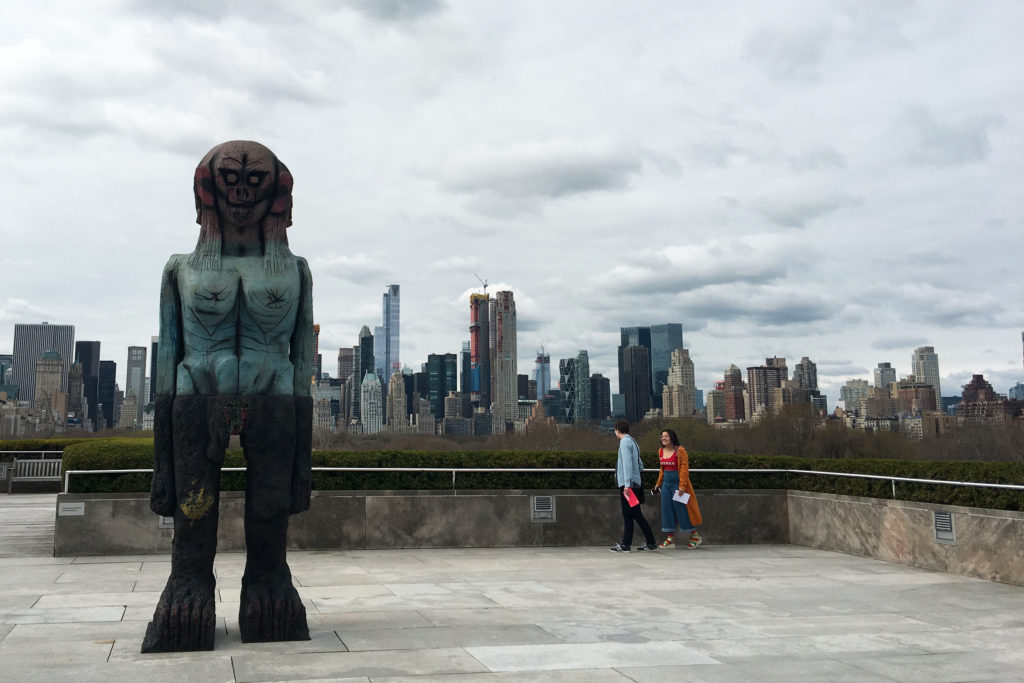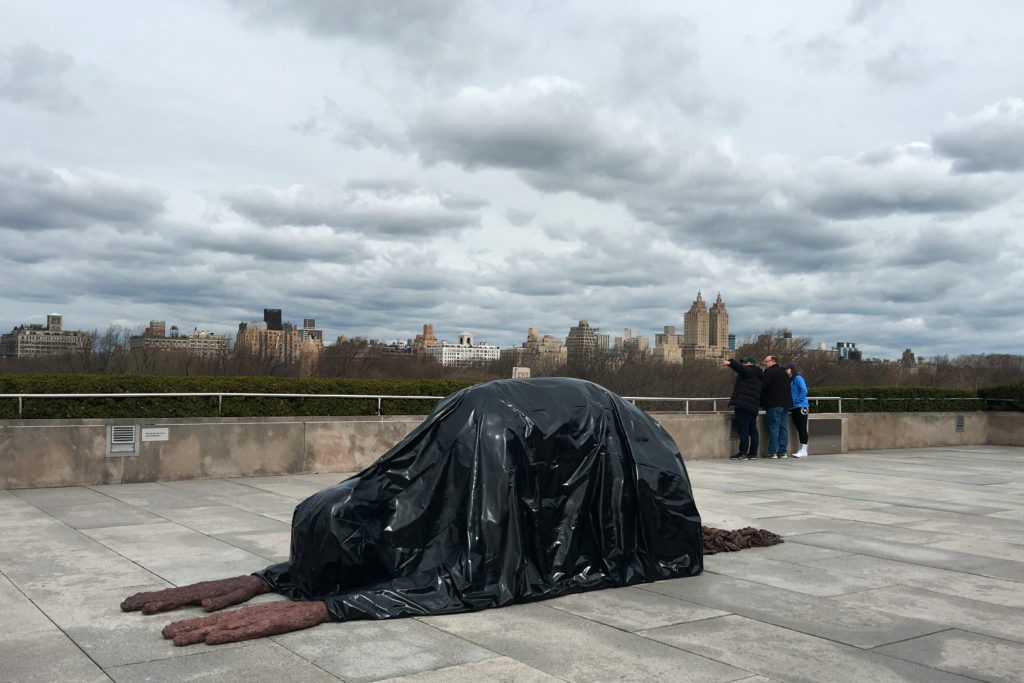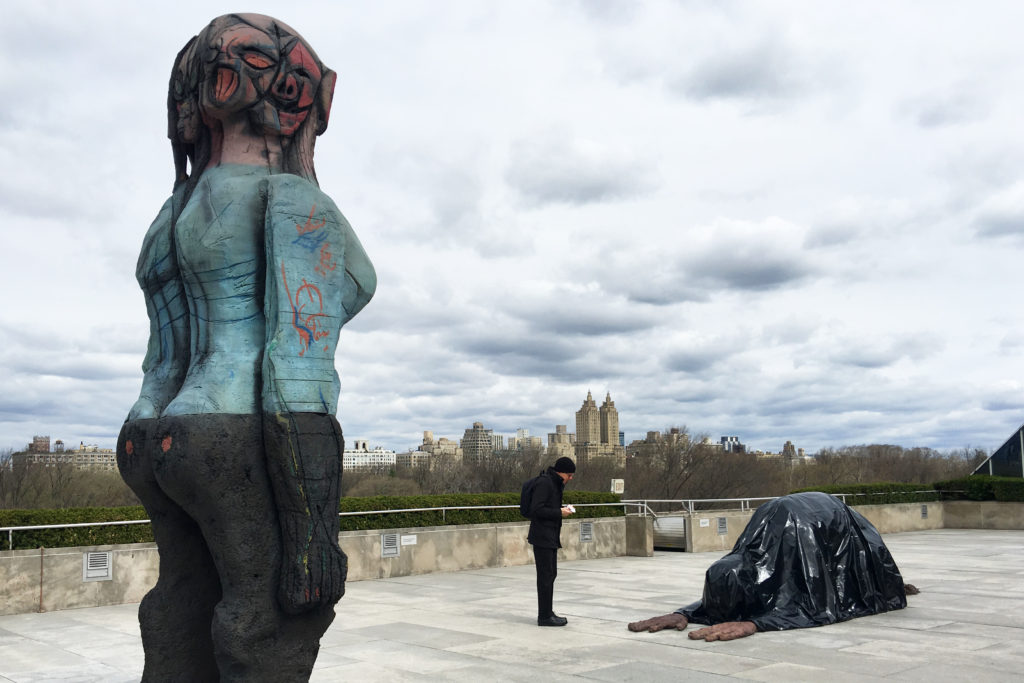As of this morning, the roof of the Metropolitan Museum in New York has become the arena for an epic confrontation. But who’s the victor and who’s the victim? And is it all over? Or is someone playing possum and planning a death blow? Hubris meets humility with the city as backdrop and witness – but the battle may only be momentarily paused. Here’s our photo journey to Huma Bhabha’s We Come in Peace, the 2018 Roof Commission at the Met Museum in New York.
An annual visit to the outdoor roof garden at the top of the Metropolitan Museum is a treasured rite of spring for many. That’s in part because every year, something totally different awaits. Sometimes the terrace plays host to fairy-tale whimsy. In recent years, the mood has been apocalyptic and filled with dread. Silhouetted against the Manhattan skyline, one year there was a replica of the home featured in the classic movie Psycho; in another there was a cloud city. Last year there was something truly wondrous strange.
And this year? The roof is the stage for an epic struggle – or perhaps a final capitulation. It’s not pretty. It’s raw and difficult – and it feels just right for this moment in time.
Pakistani artist Huma Bhabha was selected to create this year’s site-specific installation for The Met’s Iris and B. Gerald Cantor Roof Garden. Called We Come in Peace, the museum states that Bhabha’s work “addresses themes of colonialism, war, displacement, and memories of place. Using found materials and the detritus of everyday life, she creates haunting human figures that hover between abstraction and figuration, monumentality and entropy.”
What does that mean? Dear reader, come along with us, and we’ll share what saw when we visited on the opening morning of the installation.
When we first emerged from the narrow hallway entrance into the expansive terrace, our eyes went immediately to a monstrous, 5-headed, towering figure that appears to be angry, vengeful and mean. With the midtown skyline as backdrop, at first glance we saw an alien who had landed in our fair city and beaten us all into submission. If that reminds you of how you felt in early November 2016 after the last Presidential election, we feel you.

Huma Bhabha Roof Commission 2018 Met Museum New York. Photo Credit: Dandelion Chandelier.
Our gaze swiveled over to the other sculpture in the installation – a large figure, prostrate on the ground, hands visible and outstretched, and covered in what appears to be a dark trash bag. The figure has a tail, and that’s the only other feature we can see of it.

Huma Bhabha Roof Commission 2018 Met Museum New York. Photo Credit: Dandelion Chandelier
Which begs the question: what’s going on here?
Seen one way, it’s a tableau of domination and victory – a looming figure, a humiliated adversary – done and done. It made us feel really January 2017. It made us sad.

Huma Bhabha Roof Commission 2018 Met Museum New York. Photo Credit: Dandelion Chandelier
But then we looked closer, and we saw the possibility of a very different narrative. On closer inspection, it’s clear that the towering figure is female – her hair, breasts and buttocks are clearly femme. Seen in that light, the tall figure seems to have been viciously attacked and hurt – there are red marks all over her, she has numerous deep cuts, and her feet – while solidly grounded – appear to have been ravaged by fire, or covered in dirt. This woman has come through something horrible. And yet she’s still standing. In fact, she’s the alpha in this vignette.
When seen in this light, then, is the figure kneeling before her a man? Perhaps a man who caused a lot of that damage? One simple interpretation is that in an era of #MeToo, this is what victory looks like. The woman, bloodied but unbowed. The man – a rat with a tail – prone on his knees on the floor, demonstrating complete submission, and consigned to history’s garbage heap.

Huma Bhabha Roof Commission 2018 Met Museum New York. Photo Credit: Dandelion Chandelier
Then we considered the possibility that whatever this epic struggle is, it’s not over yet. The dominating figure may be temporarily on top, but who’s to say that the adversary is truly defeated? Every good horror movie has taught us is that the monster is never really dead. So whether you side with the defeated or the victor, don’t get cocky. You have no idea what’s going on underneath that tarpaulin.
The notes that accompany the installation state that the title of the work is borrowed from the classic 1951 American science-fiction film The Day the Earth Stood Still – a tale of the first contact between humans and aliens. It might bring to mind the first time Native Americans saw the Europeans who had sailed to their land. The first time the enslaved met the oppressor. The tension is the one inherent in any first encounter between very different civilizations, nations — and people. Do we convey aggression, trust, domination or vulnerability?
Don’t you love the way great art provokes? We could happily debate what this installation means over a cocktail from the splendid bar that will soon open on the Met roof. We’re thinking sunset, warm breeze, smart conversation and a delicious drink. That’s what summer in New York is supposed to be all about.
If you choose to explore this particular installation, you have until October 28th (too bad it will be gone before Halloween night). We’d love to know what you think it means. In the meantime, we’re taking this magnificent work as further proof that in times like these, it pays to stay alert. ‘Cause the struggle is real.
Join our community
For access to insider ideas and information on the world of luxury, sign up for our Dandelion Chandelier newsletter. And see luxury in a new light.

